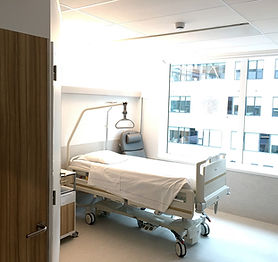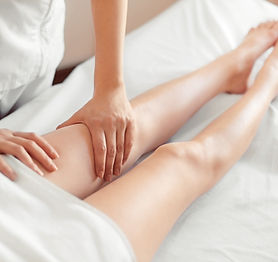Why replace the knee joint?
TOTAL KNEE REPLACEMENT
YOUR CARE PATH
This is a resumé of your care path. You can find an extended, interactive version - including notifications - in the AZ Alma app, available for download on your smartphone or tablet in the Apple App Store (iPhone & iPad) or the Google Play Store (Android).

Before surgery

35 days before treatment
Info session
About a month before your surgery, you will be invited to this meeting, where you will be familiarized with the many different disciplines and therapists you will come in contact with during your rehabilitation.

15 days before treatment
Medical exam
About two weeks before your surgery, you need to book an appointment with your GP for a medical exam. He or she will also talk you through your medication guidelines, which can be important for diabetics, for instance. State explicitly which medication you are not allowed to take or are allergic or sensitive to.

12 days before treatment
Preparations at home
-
Make sure you have closed shoes
-
Get crutches
-
Avoid loose wires
-
Remove non-fixed carpets
-
Consider applying for housekeeping help
-
Driving: ask your insurer
-
Consider moving your bed downstairs
-
For an overview: watch this video

1 days before treatment
Phone call
The hospital will call you when you may come over. We try to keep waiting times as short as possible. If your surgery is scheduled in the afternoon, you probably only have to arrive late that morning.

21 days before treatment
Pre-Operative Consultation
After your first appointment with dr. Van den Wyngaert, you may attend the POC, where AZ Alma's nurses help you with all necessary documents. If this is not possible, please make another appointment via phone (+32 (0)9 310 06 43, available weekdays 8:30-18:30) or via e-mail (preoperatieveconsultatie@azalma.be).

14 days before treatment
Quit smoking
Non-smokers rehabilitate faster and have a smaller chance of complications. Dr. Van den Wyngaert strongly advises you to quit smoking before your surgery.

2 days before treatment
Bring to the hospital
-
Shorts
-
Closed shoes or slippers, maybe a long shoehorn
-
Crutches or a walker
-
Your home medication (pills and/or shots)
-
Your GP's forms and a signed Informed Consent document

Day of treatment
Fasting
You cannot eat, drink or smoke within six hours before surgery. An exception to this rule is any necessary home medication, which you may take with a sip of water. When in doubt, consult your GP.

21 days before treatment
Preparatory exercises
To improve the speed of recovery after surgery, you can already start doing some preparatory exercises, preferably assisted by a physiotherapist. He or she will teach you how best to bend and stretch your knee, walk with crutches and get in and out of the car or bed. Have a look at the exercises in this video. You can find further explanation in the AZ Alma app (see box at the top of this page).

10 days before treatment
Fill out forms
Don't forget to fill out the required forms:
-
Informed Consent: gives the surgeon permission to operate
-
POS: gives permission for narcosis
You can find both documents in your care folder.

2 days before treatment
Do NOT bring
-
Jewellery, wallet and other valuables
-
Leave accessories like artificial nails, piercings, (ear)rings etc. at home
-
Remove false teeth, glasses or contact lenses before surgery
-
Don't remove your hearing aid; this makes for easier communication
In hospital

Day of treatment
Arrival
After you register at the reception desk, the admission nurse will welcome you to the nursing ward and prepare you for surgery. You may hand her your home medication, blood group card and insurance form.

Day of treatment
Waking up
Once all body functions are stable (breathing, blood pressure, heart rate, pain control, condition of the wound), you return to your room. As soon as you feel well and not nauseous, you may cautiously start drinking again. The next morning you can start with a light breakfast.

1 day after treatment
Rehabilitation
The physiotherapist and ergotherapist start your rehabilitation process the day after the operation. We opt for a quiet approach, below the pain threshold. The first goal is to counteract any swelling of the operated knee and start mobilizing it gently. During the first few days, keep your knee stretched as much as possible, with your leg elevated on a wedge pillow.

Day of treatment
Anesthesia
Your time under narcosis is kept as short as possible. Anesthetics are therefore only administered just before the start of the operation. The anaesthesiologist will observe you during anesthesia, taking the appropriate measures and precautions and setting up an individually adjusted treatment.

Day of treatment
In the room
In your room, oxygen is administered to you via a nose mask. Pain relief is applied via infusion. You are frequently checked up on and can get an ice pack against any pain, swelling or bleeding. You may get out of bed if you feel up to it, but please ask your nurse or physiotherapist first. It is important that you immediately start moving your knee, foot and ankle.

2 days after treatment
Ergotherapy
The ergotherapist will guide you towards independent functioning after your discharge. You will learn how to walk with crutches, climb stairs and get out of a chair or bed without overloading the knee. Curious as to how? Watch the video.

Day of treatment
Surgery
Dr. Van den Wyngaert leads the operation, which takes about one hour. Click here for more information about the total knee replacement procedure.

1 day after treatment
Pain medication
A blood sample is taken in the morning. If the result is okay, you have eaten your breakfast without any problems and you are not feeling sick, the infusion is removed. Pain relief is now administered in the form of pills, which will be offered to you at regular intervals.

4 days after treatment
Discharge
Discharge from the hospital is considered when you can lift the operated leg completely stretched, get in and out of bed, walk with crutches or a walker and take stairs. Also, the wound must be dry.
Rehabilitation

4 days after treatment
Home again
After your discharge from the hospital, you start your rehabilitation either at home or in a rehabilitation center. Part of the exercise program can be done at home. Always exercise well below the pain threshold and in function of the swelling. Build up gradually to avoid overloading of muscles and tendons, which can cause inflammation and swelling.

14 days after treatment
Stabilization therapy
Stabilizing exercise therapy begins after about two weeks, provided that you have sufficient muscle control and knee stability while standing and walking. Start carefully, supporting your weight on both legs, to avoid overloading. After six weeks you can move on to more active exercises, also on one leg, depending on your physical condition and the advice of the physiotherapist.

21 days after treatment
Quadriceps exercises
Before you start training the quadriceps (the large upper thigh muscle), it is crucial to have a dynamic balance between the inner and outer forces that stabilize the kneecap. Otherwise, the weak inner thigh muscle must be strengthened first. That is why we advise you to initially only do closed chain quadriceps exercises (i.e. with foot support), e.g. on an exercise bike.

50 days after treatment
Activities
When cleaning, never step on an unstable stool, instead use a sturdy stepladder with wide steps. When gardening, attach a long handle to small tools. If you have to kneel down, use your non-operated knee and not both knees. You may start driving as soon as you can go up and down the stairs without assistance, but first discuss this with your insurance.

5 days after treatment
Therapy session
During the therapy session we let you practice as much as possible, depending on your ability. The role of the therapist is individual guidance. If necessary, he or she may suggest draining therapy, massage or electrotherapy.

14 days after treatment
Stitch removal
On day 14-16 after the operation your wound should be sufficiently healed to remove the stitches. Make an appointment with your doctor.

21 days after treatment
Blood test
Three weeks after surgery, your doctor will perform a final blood check. Please bring the results of this blood test to your appointment with Dr. Van den Wyngaert six weeks after treatment. If applicable, you may resume taking your blood thinners (provided that the wound is dry).

168 days after treatment
Sports & recreation
From the sixth month onwards you should be able to resume your sports activities, provided that you have complete knee mobility, no swelling or pain during or after activities, good stability and sufficient strength. From now on it should be safe to kneel down on both knees again.

7 days after treatment
Doctor's appointment
The healing process of the wound should be checked one week after surgery. Make an appointment with your GP or home nurse.

16 days after treatment
Practice knee flexion
After the stitches have been removed, you can start practicing knee flexion. Sit on a chair and bend the knee as far as possible with the aid of the roller skate provided to you in hospital.

42 days after treatment
Surgeon's appointment
Six weeks after the operation, you have an appointment with dr. Van den Wyngaert. Please bring the following:
-
Results of the blood test performed by your GP
-
Data from your radiography check at the hospital
-
You can find the referral slips in your care folder.
Orthopedic surgeon - specialized in the treatment of knee injuries